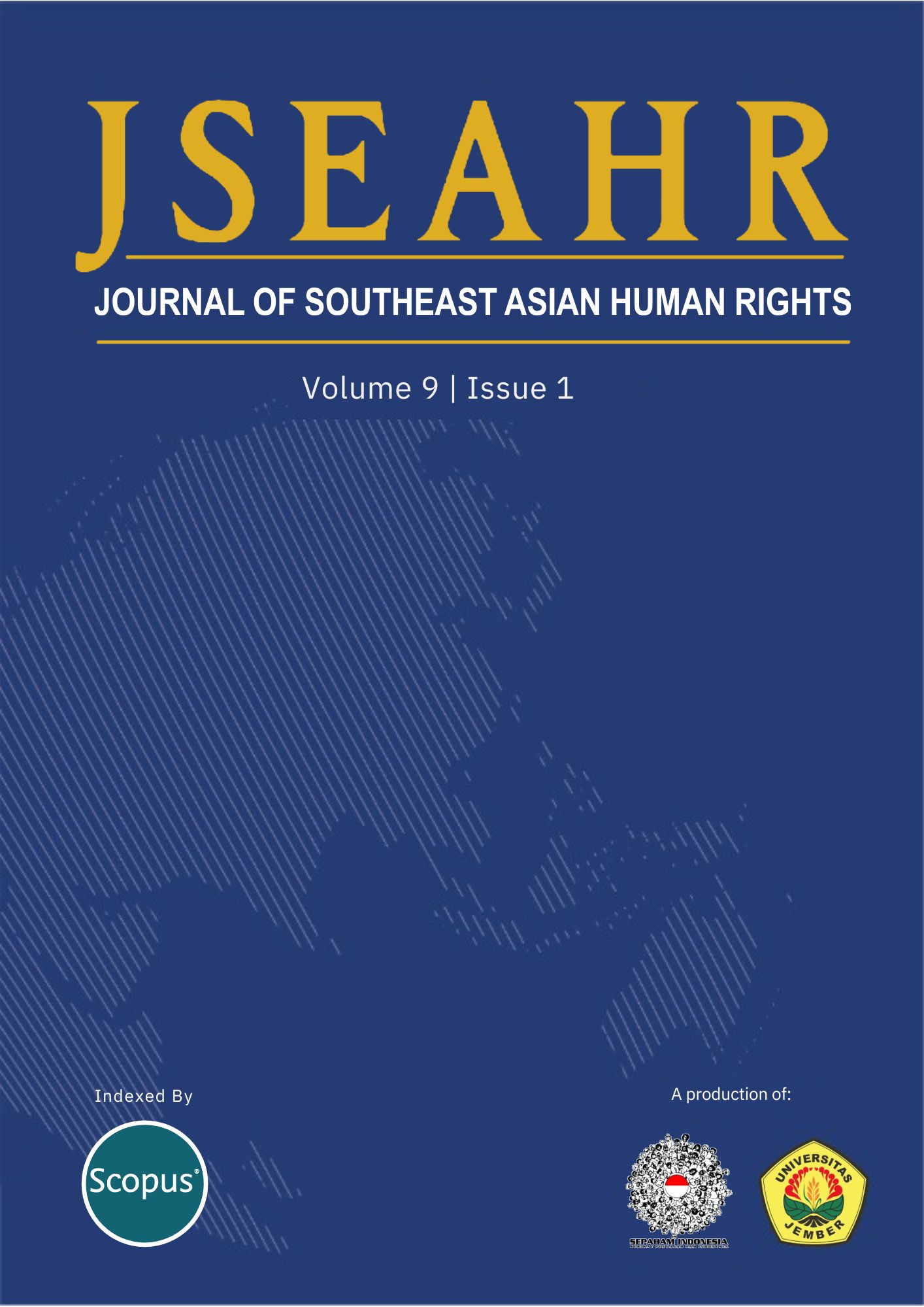The Abolition of Forced Labor in Vietnam
Is it Compatible with ILO's Standards?
DOI:
https://doi.org/10.19184/jseahr.v9i1.43855Keywords:
abolition, forced labour, harmonization, ILO labour standards, VietnamAbstract
This article analyzes the legal problems in the identification of forced labor and the provisions for the abolition of forced labor in Vietnamese law compared with the core international standards. This article points out the inconsistencies and lack of specificity in Vietnamese law compared to International Labour Organization (ILO) Conventions, specifically regarding the definition of forced labor and the identification of the perpetrators of such acts. Furthermore, the paper analyzes the manifestations of forced labor in Vietnam, as well as challenges in the law enforcement process due to the lack of harmonization between national law and core international labor standards ratified by Vietnam. To implement this research, the author has compared the content of Vietnamese law with ILO regulations on eliminating forced labor (Convention No. 29 and Convention No. 105) in aspects such as the concept and identification of forced labor; regulations on subjects affected by forced labor, the people performing forced labor, and how to address forced labor; and the forms of forced labor which take place in Vietnam. On that basis, the article identifies the legal contents that need to be improved to eliminate forced labor in Vietnam. These include the necessity of specifying the manifestations of forced labor acts; ensuring consistency in identifying the perpetrators of forced labor; and amending and supplementing the elements constituting the crime of forced labor in the Criminal Code, with an emphasis on incorporating consequential elements regarding both physical and mental health.
Keywords: abolition; forced labor; Labor Code; ILO labor standards; Vietnam
Downloads
References
Jurabek Rasulov, Odiljon Sulaymanov,. “ABOLITION of FORCED LABOUR: CASE of UZBEKISTAN.†Psychology and Education Journal 58, no. 1 (February 1, 2021): 4564–80. https://doi.org/10.17762/pae.v58i1.1563.
Le, Luong, and Dr Caitlin Wyndham. “What We Know about Human Traffickers in Vietnam.†Anti-Trafficking Review, no. 18 (April 19, 2022): 33–48. https://doi.org/10.14197/atr.201222183.
Nguyen, Oanh, and Toi Le. “Perceptions of Governmental and Nongovernmental Actors of Human Trafficking Victims: The Case of Vietnam.†International Journal for Crime, Justice and Social Democracy 9, no. 4 (February 15, 2021). https://doi.org/10.5204/ijcjsd.1559.
Books
Faure, Juliette. Forced Labour: Does It Make Economic Sense? United Nations University, 2015.
International Labour Organisation. Global Estimates of Modern Slavery Forced Labour and Forced Marriage. International Labour Organization, Walk Free, and International Organization for Migration, 2022. https://www.ilo.org/wcmsp5/groups/public/---ed_norm/---ipec/documents/publication/wcms_854733.pdf.
International Labour Organization and International Finance Corporation. Progress and Potental: How Better Work Is Improving Garment Workers’ Lives and Boosting Factory Competitiveness: A Summary of an Independent Assessment of the Better Work Programme. International Labour Office, 2016.
International Labour Organization. Global Estimates of Modern Slavery: Forced Labour and Forced Marriage. International Labour Organization and Walk Free Foundation, 2017. https://www.ilo.org/wcmsp5/groups/public/@dgreports/@dcomm/documents/publication/wcms_575479.pdf.
International Organization for Migration . Vulnerabilities and Risks of Exploitation Encountered by Vietnamese Migrant Workers—a Qualitative Study of Returnees’ Experience, 2020. https://publications.iom.int/system/files/pdf/Vulnerabilities-and-Risks-of-Exploitation_1.pdf.
Interparlamentarische Union, and Inter-Parliamentary Union . Eliminating Forced Labour. Geneva Inter-Parliamentary Union, 2019.
Sreedharan, Liva, Aarti Kapoor, and Hoa Nguyen. Sitting on Pins and Needles a Rapid Assessment of Labour Conditions in Vietnam’s Garment Sector Commissioned by Anti-Slavery International Sitting on Pins and Needles: A Rapid Assessment of Labour Conditions in Vietnam’s Garment Sector Contributions a Rapid Assessment of Labour Conditions in Vietnam’s Garment Sector , 2018. https://www.antislavery.org/wp-content/uploads/2019/04/Pins-and-Needles-Vietnam-supply-chains-report.pdf.
International Labour Organization, Organisation for Economic Co-operation and Development, International Organization for Migration, and United Nations Children’s Fund . Ending Child Labour, Forced Labour and Human Trafficking in Global Supply Chains, 2019. https://www.ilo.org/wcmsp5/groups/public/---ed_norm/---ipec/documents/publication/wcms_716930.pdf.
Legal Documents
ILO. “Convention C029 - Forced Labour Convention, 1930 (No. 29).â€.
ILO. “Convention C105 - Abolition of Forced Labour Convention, 1957â€.
United Nations General Assembly, Universal Declaration of Human Rights, 10 December 1948, 217 A (III)
The Government of the Socialist Republic of Vietnam (2022), Decree No 12/2022/NÄ-CP: Providing penalties for administrative violations in the fields of labour, social insurance, and overseas manpower supply under contract, January 17th, 2022
The National Assembly of the Socialist Republic of Vietnam (2012) Law on Trade Unions
The National Assembly of the Socialist Republic of Vietnam (2015, 2017) Criminal Code 2015, amended 2017
The National Assembly of the Socialist Republic of Vietnam (2020) The Law on Vietnamese Guest Workers
United Nations. “International Covenant on Civil and Political Rights.†OHCHR. United Nations, 1966.
The National Assembly of the Socialist Republic of Vietnam (2019) Labour Code
Others
ILO (2012) “ILO Indicators of Forced Labour Special Action Programme to Combat Forced Labour,†October 1, 2012. https://www.ilo.org/wcmsp5/groups/public/---ed_norm/---declaration/documents/publication/wcms_203832.pdf.
Hastie, Bethany. “By Any Means Necessary: Towards a Comprehensive Definition of Coercion to Address Forced Labour in Human Trafficking Legislation Public Deposited,†2022.
Institute of Workers and Trade Unions. “[Report] the Consequences of Low Wages - a Study on Fashion Suppliers in Vietnam.†Oxfam, February 26, 2019 Accessed 7th February, 2023. https://vietnam.oxfam.org/latest/publications/report-consequences-low-wages-study-fashion-suppliers-vietnam.
International Trade Union Confederation. “Forced Labour Mini Action Guide,†2008. https://ilo.org/wcmsp5/groups/public/---ed_norm/---declaration/documents/publication/wcms_116734.pdf.
Ministry of Labour - Invalids and Social Affairs. “The Problem of Human Trafficking in Vietnam Is Taking Place Painfully.†www.molisa.gov.vn, 2021. http://www.molisa.gov.vn/Pages/tintuc/chitiet.aspx?tintucID=230088 Accessed 17:16 04th February, 2023.
Schwarz , Katarina, Ergul Celiksoy, Joanna Smętek, Ewelina Wolosik , Katarzyna Lubianiec , Agnieszka Makulec , and Todd Landman, “External Policy Tools to Address Modern Slavery and Forced Labour,†2022. https://www.europarl.europa.eu/RegData/etudes/STUD/2022/653664/EXPO_STU(2022)653664_EN.pdf.
Downloads
Published
Issue
Section
License
Copyright (c) 2025 Huyen Thanh Nguyen

This work is licensed under a Creative Commons Attribution-NonCommercial 4.0 International License.







